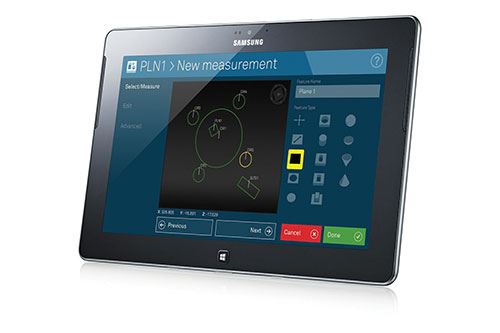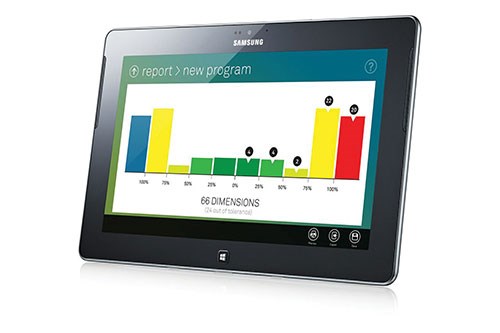Measurement Software Adopts Multi-Touch Interface
This interface shows how multi-touch technology creates an enhanced experience for users of metrology software on the shop floor.
Share




How users interact with control software on computerized manufacturing equipment generally follows developments in personal computing. The user interface offered by PC-DMIS Touch from Hexagon Metrology (North Kingstown, Rhode Island) is one of the latest examples. This software for portable arm and direct computer controlled (DCC) CMMs uses multi-touch display technology, which first became popular on smartphones and tablets.
Multi-touch enables users to select menu items, activate functions or navigate through successive display screens by gently tapping or swiping the surface of the display panel. There is no need for a keypad with pushbuttons or a clickable mouse device.
The significance of this development goes beyond the convenience or ease of use associated with a “handier” input device. Developers such as Hexagon Metrology recognize that new modes of user input and interaction should give rise to a different user experience, and the interface must be structured accordingly. In other words, the new interface makes the software easier to use, more capable or simply more immersive.
For example, the PC-DMIS Touch interface features a different workflow—that is, the sequence of steps involved in completing measurement tasks. This workflow is based on displays that intuitively prompt the user to touch or swipe icons or display items. Color is also used in distinctive ways to guide the user. It runs on any Windows 8-based tablet device.
According to developers, PC-DMIS Touch offers a new way to complete measurement tasks. One-off dimensions are executed through intuitive automated measurement sequences, while more complex measurement plans are created by measuring the features directly on the part. A graphical representation of the measured features is always displayed in the center of the interface during all measurement tasks. The software organizes measurement plan elements intuitively by “Face,” a new concept for the traditional work-plane. This guides the user through sets of inspection tools used to construct features or feature sets, perform 2D and 3D dimensional reporting, configure GD&T settings, among other functions. Each task is completed through a consistent workflow in which the user might measure a new feature, select an already measured feature from the list or directly from the graphical representation, or some combination of the three, depending on the required input.
Inspection reporting is supported with real-time report generation. As features are measured, the user selects whether to display all or part of the corresponding data on the report, while at the same time updating feature nominal and tolerance data. A swipe to the right provides access to the report with a statistical view of how the measured features are stacking up against their respective tolerance requirements.
Developers say this interface will enable shopfloor personnel with some CNC programming experience to create and run inspection programs in about 20 minutes. The portable arm version is currently ready for shipment. The CMM version is scheduled for release in October 2013.
Related Content
-
Turning Fixed-Body Plug Gages Inside Out
Fixed-body mechanical plug gages provide fast, high-performance measurement for tight-tolerance holes.
-
Rethink Quality Control to Increase Productivity, Decrease Scrap
Verifying parts is essential to documenting quality, and there are a few best practices that can make the quality control process more efficient.
-
Ballbar Testing Benefits Low-Volume Manufacturing
Thanks to ballbar testing with a Renishaw QC20-W, the Autodesk Technology Centers now have more confidence in their machine tools.

























.jpg;maxWidth=300;quality=90)

